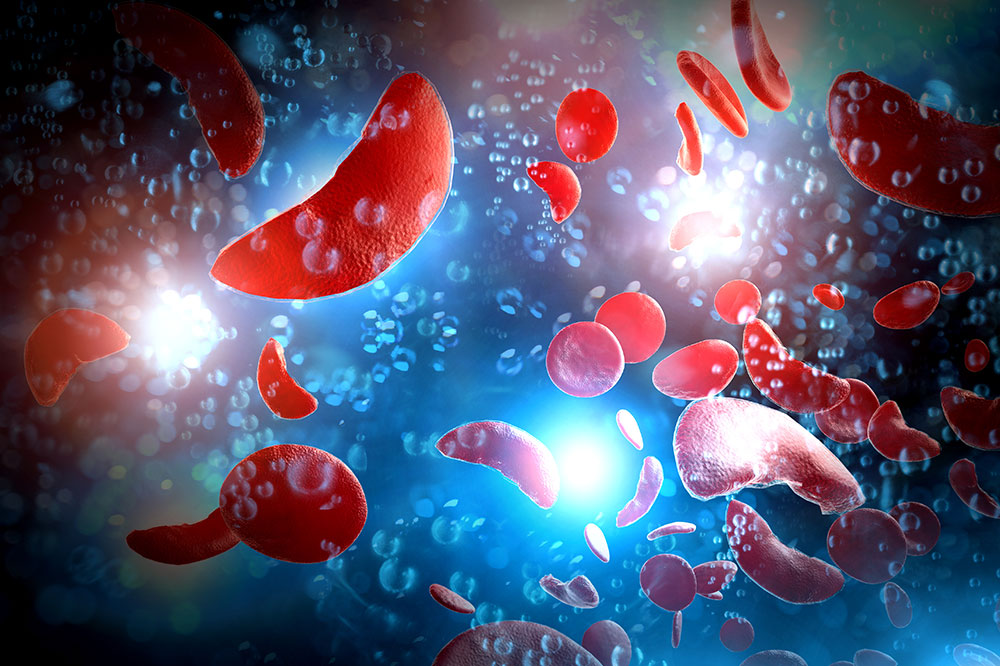
12 side effects of sickle cell anemia
Sickle cell anemia, also called sickle cell disease (SCD), is a potentially life-threatening disorder of the red blood cells (RBCs) – one of the four blood cells that carry oxygen from the lungs to the rest of the body. In a person suffering from sickle cell anemia, there are not enough healthy RBCs to transport oxygen. In addition, the shape of the RBCs also change. Usually, they are shaped like discs, which allow them to travel through the blood vessels easily. But due to sickle cell anemia, RBCs become disfigured and look like sickles or crescent moons. This slows down the flow of blood.
While treatment can address the problem and reduce the pain, it causes several complications. Here, we discuss some of the side effects of sickle cell anemia.
Sickle chest syndrome
A severe sickle cell crisis, sickle chest syndrome, causes severe chest pain and symptoms like cough, fever, sputum production, shortness of breath, and low blood oxygen levels. The disease can, in turn, lead to pneumonia or the death of lung tissue (pulmonary infarction). It is also a leading cause of death for sickle cell disease patients.
Hand-foot syndrome
Hand-foot syndrome is a common side effect of many cancer treatments. However, it can be triggered due to sickle cell anemia as well. It occurs when sickle-shaped RBCs block blood vessels in the hands or feet, causing redness, swelling, and pain on the palms of the hands and feet. The disease can also cause leg ulcers. In fact, swollen hands and feet are often the first sign of sickle cell anemia in babies.
Lung disease
Lung disease is caused by the decreased blood flow and can result in high blood pressure in the lungs (pulmonary hypertension) and scarring of the lungs (pulmonary fibrosis). While lung disease can occur in any patient with sickle cell anemia, it is diagnosed sooner in patients with sickle chest syndrome. The damage makes it more difficult for the lungs to transfer oxygen into the blood, resulting in frequent sickle cell crises.
Splenic sequestration
This potentially life-threatening condition triggered due to sickle cell disease happens mostly in children. The disease causes the child’s spleen to get bigger and lowers the amount of oxygen-carrying RBCs in their body. It causes a sudden, painful enlargement of the spleen. Doctors may have to remove the spleen due to complications of sickle cell disease through a procedure known as a splenectomy.
Stroke
As mentioned, one of the biggest problems of sickle cell anemia is that it affects the flow of blood. This has serious consequences, with stroke being one of them. Sickle cells can block blood flow to an area of the brain. Patients may then experience seizures, weakness or numbness of arms and legs, sudden speech difficulties, and loss of consciousness.
Priapism
Men with sickle cell anemia can experience priapism. This is an unwanted condition characterized by a persistent, painful erection that may last for up to four hours or more. It develops because the blood vessels in the penis get blocked, trapping blood in it. Health experts usually treat the problem by draining the blood from the penis or using medications that restrict blood flow to the organ.
Gallstones
Gallstones are deposits of bile that form in the gallbladder. Unlike the other side effects of sickle cell anemia, gallstones are not caused due to problems with blood flow. They are, instead, caused by the breakdown of RBCs. Although most gallstones are not serious, they can become a problem if not treated correctly.
Acute chest syndrome
Chest pain, cough, fever, and lung infiltrates are some common symptoms of this disorder. It can be caused because of sickling in the small blood vessels in the lungs. In most cases, acute chest syndrome requires emergency medical treatment. Standard methods include antibiotics, oxygen, breathing exercises, and blood transfusion.
Delayed growth
The lack of oxygen and nutrients reaching every part of the body can lead to stunted growth. Consequently, children with sickle cell anemia might be shorter. Sexual maturation can also be delayed by around two years.
Pulmonary hypertension
Adults with sickle cell anemia may develop high blood pressure in the lungs, which can cause shortness of breath and fatigue. Since this problem can worsen over time and turn fatal, it is crucial to seek medical help immediately. Pulmonary hypertension can be treated through medicines and oxygen therapy.
Organ damage
Organ damage is again associated with the lack of blood flow to various organs. In sickle cell anemia, oxygen levels are low in the blood. This lack of oxygen-rich blood can prove fatal, damaging nerves and organs, including the kidneys, liver, and spleen.
Pregnancy complications
Pregnant women with sickle cell anemia are at risk of high blood pressure and blood clots. The risk of miscarriage, premature birth, and low birth weight babies is also more due to the disease. Further, women can transfer the disease to the child during delivery.




